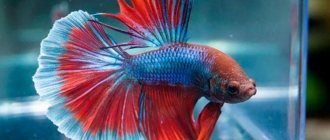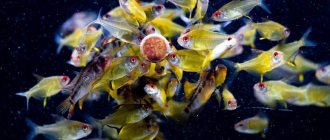For example, miniature Guppies reach a respectable age by the age of four, and Goldfish at this time are just entering their “coming of age” and successfully live up to 15 years or more.
In the second case, it is quite natural that if the fish are kept in unsuitable conditions (dirty water, poor nutrition, aggression from neighbors in the aquarium), then life expectancy is sharply reduced. At the same time, in a favorable environment, they will live their maximum life. However, here too everything is not so obvious.
Lifespan of popular fish species
Different species of fish have significantly different life expectancies: some live no more than a year, while others live over 25 years. The lifespans of popular aquarium phenotypes are as follows:
| Catfish | These include otocinclus, tarakatum, mystus, glass catfish and others. They live from 5 to 15 years. |
| Characinaceae | Representatives of the family live approximately 5 to 10 years. These include popular types: tetras, neons, minors and pacu. |
| Carp | Long-lived aquarium fish, because their lifespan ranges from 5 to 30 years. Among them: morulis, labeo, goldfish, cardinal fish. |
| Cichlids | Duration ranges from 5 to 18 years. These are angelfish, discus, astronotus, labidochromis, frontosa and others. |
| carp-toothed | Representatives live on average from 3 to 15 years, among them are: mollies, guppies and platies. |
| Loaches | The family is represented by fish such as loaches and loaches. Lifespan is 10-15 years. |
How long do cichlids live?
There are several hundred species of cichlid aquarium fish and their varieties. On average, their lifespan in an aquarium is 8–10 years. Maybe they could live longer, but their violent temperament often leads them to injuries, after which you can see how the fish died.
The average lifespan of cichlids in an aquarium is 8–10 years.
Black-striped cichlids, meeks and angelfish are considered the most picky to care for. This increases their chances of living longer.
How many years do goldfish live?
Goldfish, like many other carp fish, are considered long-lived. Their lifespan can be up to 25 years. The record holders are those that live in fairly cool water. In addition, goldfish are very peaceful, which helps them coexist with many similar species.
One of the representatives of the carp family, the goldfish, was recognized as a long-liver, as it lived in captivity for 30 years.
How long do guppy fish live?
Guppies are miniature viviparous fish, unpretentious and tenacious.
In aquarium conditions they usually live longer than in the wild; the life expectancy of guppies is from 2 to 4 years. There may be cases where they live for about 5 years.
If the fish died before this period, it means that, despite their unpretentiousness, their care was incorrect and they were exposed to diseases.
The lifespan of a guppy is from 2 to 4 years
Gourami
Gourami will live longer in an aquarium compared to being in natural conditions. They can live 5-7 years, and with proper care they can live up to 10 years.
Marbled gourami, very capricious for breeding, but more resistant to living conditions and diseases, reaches the age of 8 years.
How long do zebrafish live?
In the wild, zebrafish can live only 1 year, but at home - up to 5 years with a responsible approach to their maintenance.
Currently, bred zebrafish can live up to 7 years of age.
Zebrafish live up to 5 years at home
Som
There are about 800 varieties of aquarium catfish. Small species like ancistrus live 6-8 years, the miniature corydoras catfish will not reach 5 years, but large sacbranch catfish easily reach the age of 20 years.
Under natural conditions, large varieties live 100 years or longer.
Vynovye
Loaches
Common loaches are distinguished by good health and can live up to 12 years, on average - 10-11. There is an interesting pattern: the endurance of these fish is inherited. If parents knew how to adapt to unfavorable conditions, their offspring will develop this positive quality even more strongly.
Bocia
Botia live a relatively long time - 12-15 years, while very rarely this figure was out of the average - outstanding long-livers, as well as a large number of early deaths - statistically few.
Factors affecting the lifespan of fish
When acquiring a certain phenotype, you need to find out how long aquarium fish of this species live, because many owners manage to fall in love with their pets and bitterly regret the death of the fish. In addition, experienced breeders who sell various types of fish try to have complete information about the lifespan of their fish, since this knowledge is important for counting spawnings.
Despite the fact that each phenotype is characterized by an individual number of years, sometimes the life of fish is shortened or suddenly ended due to incorrectly selected neighbors or poor living conditions. In this case, you need to try to protect your pet by creating suitable living conditions for the fish. The following factors influence how long aquarium fish live:
- size;
- diet;
- water parameters;
- neighborhood.
The lifespan of fish is affected by diet
A beginner needs to carefully study the rules for keeping future pets, because the life expectancy of aquarium fish will directly depend on the strictness of their compliance.
Gender of the fish
An interesting fact is that gender also affects lifespan: according to statistics, male fish live 1-2 years longer than female fish.
Females often die due to exhaustion of the body from frequent periods of spawning, as well as as a result of its unsuccessful outcome (particularly in viviparous breeds).
Type of fish
This is a decisive factor in the life expectancy of aquarium inhabitants. Even with careful care, it is not possible to exceed their average lifespan to a greater extent.
It is reliably known that egg-laying species have a greater number of life years than viviparous species.
Albinos are quite picky about the conditions of their detention, as a result of which the duration of their existence is much shorter.
Selected varieties require more complex care, because the process of their elimination weakens the possibilities of adaptation. Fish of a dark color, for example, blue, black, etc., are also considered less tenacious.
Less durable fish that are dark in color, such as blue or black
The life cycle of various marine fish in an aquarium ranges from 2 to 10 years.
Character of the individual
When selecting neighboring individuals in an aquarium, their character should be taken into account. Most fish can adapt to water parameters, but it’s unlikely to adapt to the nature of an aggressive neighbor. There are very frequent cases of deaths of peaceful fish from the teeth of predators or unfriendly individuals.
The fighting nature of fish greatly shortens their lifespan: frequent clashes with relatives or neighboring inhabitants of similar character lead to their untimely death.
Breed and size of fish
One of the main factors on which the lifespan of aquarium fish depends is the size of the pets. The size of an individual's body determines its lifespan: small fish, growing up to 5 cm in length, live on average from one to five years. These include neons, guppies and swordtails.
Small fish, growing up to 5 cm, live on average from one to five years
Phenotypes whose sizes reach medium length can live in an aquarium for up to 15 years, and some large species - up to 25 years.
However, although size is an important indicator, sometimes surprising deviations still occur: science knows of fish species that die after laying eggs or giving birth to offspring - most representatives of the salmon family die after spawning.
Interesting fact: the lifespan of the smallest fish in the world, the cinolebias, depends on the duration of the rainy season.
Neighborhood
How long aquarium fish live is influenced by the neighbors in the aquarium, because the correct selection of inhabitants for the tank is the key to harmony and balance in the aquatic environment. Each phenotype has an individual character: bettas are cocky and pugnacious fish, so keeping fighters with small guppy fish is not worth it. Large and aggressive species can easily attack a weaker neighbor and will happily feast on it, so fish species for a pond should be selected in accordance with compatibility.
It is important to control not only the compatibility of pets, but also the number of fish in the tank. Overpopulation of a reservoir leads to sad consequences: lack of oxygen, aggression and disease, which is why many inhabitants die.
It is important to control not only the compatibility of fish, but also their number
Botia clown - “talkative” striped barbels
Having populated a large aquarium with lively, very bright and beautiful clowns, you will be able to communicate with them for a long 15 years. And communicate in the literal sense of the word - the mustachioed representatives of the loach family will thank you with a characteristic click for the food they like.
Clown loaches are agile and bright bottom-dwelling schooling aquarium fish
In captivity, fish grow up to 20 cm and live in schools, so they need a spacious aquarium: at least 400 liters per school of 3-5 individuals. Take care of good aeration of the artificial reservoir, its cleanliness, the constancy of such parameters as light, temperature, acidity and water hardness, as well as the presence of numerous shelters in which the fighting creatures can rest from annoying attention.
How to extend the life of fish
In order for the fish to live longer, it is necessary to follow all instructions for care and maintenance. Species-specific water parameters must be observed. It is recommended to equip the container with pets with devices for aeration. You need to clean the aquarium and change the water weekly. Food must be given to fish taking into account their specific needs, avoiding overfeeding.
To minimize stress, you need to plant a sufficient number of plants in the reservoir, equip shelters for the fish, and place shelter decorations.
To minimize stress, you need to plant a sufficient number of plants
Overpopulation negatively affects the life expectancy of aquarium inhabitants. To avoid problems when keeping them together, it is better to select species of similar sizes, similar in character and behavioral characteristics.
It is important to start treating sick fish on time, without triggering the development of the disease, isolating them from the aquarium to avoid an epidemic.
Smart neighborhood
Often, in pursuit of the aesthetic beauty of the aquarium, novice owners miss this point. In such situations, a common tank turns out to be a not entirely comfortable place for all inhabitants:
- Large predators begin to eat smaller neighbors - what are the chances of the latter living all the time allotted to them by nature?
- Territorial fish clearly monitor their zone - they firmly drive away everyone who invades it. And then what should the rest of the inhabitants do, who prefer to live in the same layer of the aquatic environment? Just feel stressed and hide.
- Phlegmatic fish with luxurious fins constantly suffer from hooligan, hyperactive neighbors - they will definitely bite and rip off tails and fins, while the victims not only experience stress, but also often get sick and do not live long.
- Many representatives of the breeds cannot stand their own brothers. For example, just a couple of cockerels can turn an aquarium into a constant battlefield, and these fighting fish fight not only until first blood is drawn.
These are not all unfortunate combinations of creatures forced to live in the same territory due to the “light hand” of the owner.
How to determine the age of aquarium fish
Young animals can be identified by the activity of movement, the healthy shine of their scales, and clear eyes.
Elderly or sick fish are not active, often motionless in the bottom of the aquarium.
Only in some species are signs of the onset of old age clearly visible. For example, thorns lose their color, barbs lose their scales, and macropods swim with drooping fins.
For the most part, the fry look paler in comparison with the brightly colored adults. Swordtails acquire a beautiful color only six months after birth.
Swordtails acquire a beautiful color only 6 months after birth
Juvenile goldfish have a greenish-bronze coloration and a rounded tail fin. Young Ancistrus catfish do not have antennae on their faces; they grow only in the second year of life.
Young animals are smaller in size than adults. But you need to ask the seller about the conditions for keeping the fish before purchasing. Pets' small size may indicate inadequate care.
Temperature indicators
The water temperature has a significant influence on the duration of the life cycle of the inhabitants of the aquarium. The peculiarity of cold-blooded creatures is that they are not able to independently regulate their body temperature, so water performs this function. The temperature of the water in the tank is the same for its inhabitants.
Read also: Proper mixed food for a cat
The warmer the aquatic environment, the more active the metabolism in the fish’s body. This leads to faster wear and a shorter life cycle. In some cases, the life of fish becomes shorter by more than one year.
Question answer
How long can aquarium fish live without food?
Underfeeding of fish, as well as overfeeding, negatively affects their health, which leads to a disruption of the natural color, a decrease in immune abilities and activity.
For some species of fish that lead a sedentary lifestyle, fasting will even be beneficial. But such as cichlids, catfish, angelfish and neons need a lot of food, so fasting is very harmful for them. These species can live without food for only 1 week.
The fry, although they require frequent feeding due to their incredible mobility, will be able to go without feeding for about four days.
Predatory fish species, algae eaters and loricariid catfish are able to live without food for 10 days, but at the same time they will eat all the algae and the remains of food that have settled on the substrate.
Predatory fish species can live without food for 10 days
Overfed and obese fish can go without feeding for a longer period of time than pets for whom the diet was followed.
There are record holders who are not afraid of weeks and even months of fasting. Large and commercial fish are more relaxed about the lack of food than other species.
How long does a fish live without water?
Everyone knows that a fish without water is like a man without air. But the lifespan in such conditions is very individual for each individual. Everything depends not only on the type of fish, but also on the conditions into which the fish came from the water, even on its individual characteristics. Some individuals will die literally after a couple of minutes of lack of fluid, others are able to live for another half hour. Larger fish species are more resilient.
Differences in life expectancy in an aquarium and in the wild
Aquarium fish of all types and sizes are able to live much longer than in the wild, where their lives are constantly threatened by predators or fishermen.
In the wild, they are at greater risk of getting sick, getting injured, and being exposed to unfavorable natural factors. As a result, their lifespan is reduced.
Aquarium fish are pets just like other creatures, and many owners want their beloved inhabitants of the pond to live as far away as possible. To preserve and increase the lifespan of your pets, it is necessary to follow the rules of keeping, nutrition and neighborhood, as well as take care of the place where the fish live - the aquarium.
What do you do to make your aquarium pets live longer? Share your experience with beginners?
The right diet
The lifespan of different types of aquarium fish also depends on proper, balanced nutrition. The diet is selected based on the type of specific pet. But at the same time, overeating or undereating should not be allowed.
Herbivorous and predatory fish require different food. If the former requires more fiber for a normal life, carnivorous species must receive protein in the required quantities (found in live and dried food). Fish with a mixed digestive system also require a varied, balanced diet.
“Elderly” representatives of aquatic inhabitants require increased attention and a special approach when compiling a diet.
Overcrowded reservoir
It is important to take into account the needs of the inhabitants for free space - for swimming and zoning. If you place more fish and other aquatic creatures in a container than required, you may encounter the following problems:
- living creatures will not have enough food,
- increased competition will arise - the fish will sort things out at the slightest provocation - over food, territory, different characters. Of course, we are not talking about a full, peaceful life,
- the oxygen regime of the tank is disrupted - this is one of the most common causes of death of aquarium inhabitants,
- the incidence of fish illnesses increases - they feel unwell. In addition, many diseases begin to spread, affecting more and more individuals,
- aggression increases - intolerance towards neighbors can arise even among completely peaceful and calm inhabitants - and who would like constant interference from the outside?
- individuals with leadership inclinations will fight for the place of leader and leader - harshly, uncompromisingly, oppressing the weaker along the way. In a rush, cocky fish are capable of killing an opponent.
Any of the above situations causes the death of the inhabitants of the artificial reservoir. It is important that each fish has its own “living space”, and the needs of an individual of a particular breed in the volume of water should also be taken into account.











